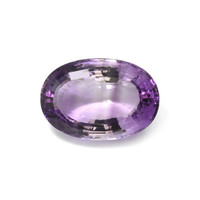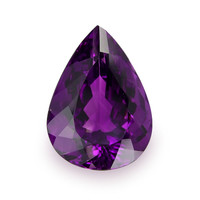Durability and Hardness of Amethyst
Introduction to Amethyst’s Durability and Hardness

Amethyst, a popular purple gemstone and a variety of quartz is not only valued for its beauty but also for its practical properties of durability and hardness. These characteristics are crucial in determining how well Amethyst withstands wear and environmental factors.
Amethyst on The Mohs Scale of Hardness
- Mohs Scale Overview: The Mohs Scale of Hardness is a tool used to measure a gemstone’s resistance to scratches. It ranges from 1 (the softest) to 10 (the hardest).
- Amethyst’s Rating: Amethyst ranks at 7 on the Mohs Scale. This means it has good resistance to scratches, making it suitable for a variety of jewelry applications, including rings and daily wear items.
Interpreting Amethyst’s Durability
- Scratch Resistance: With a hardness of 7, Amethyst can resist scratches from substances with a lower rating, like iron, but can be scratched by harder materials like diamonds or corundum (sapphires and rubies).
- Other Durability Factors: Besides hardness, Amethyst’s durability also involves its resistance to chipping and cracking. Quartz, including Amethyst, has a good level of toughness, making it relatively durable against impacts.
Caring for Amethyst Jewelry
- Cleaning Methods: Amethyst should be cleaned with mild soap and lukewarm water. Avoid harsh chemicals and abrasive materials that could scratch the surface.
- Storage: Since it can be scratched by harder materials, Amethyst jewelry should be stored separately from diamonds and other high-Mohs-rated gemstones.
- Avoiding Extreme Conditions: Prolonged exposure to extreme temperatures and direct sunlight can cause fading in Amethyst. It’s also wise to remove Amethyst jewelry during physically demanding activities to prevent accidental damage.
Balancing Beauty and Practicality with Amethyst
Understanding the hardness and durability of Amethyst, especially in relation to the Mohs Scale, is invaluable for anyone interested in this gemstone. This knowledge helps in making informed choices about purchasing and caring for Amethyst jewelry, ensuring it remains a treasured piece for years to come.



Toughness and Susceptibility to Breakage
Amethyst, known for its enchanting purple hues, possesses a unique combination of hardness, toughness, and durability. Understanding its characteristics in terms of toughness and susceptibility to breakage is essential for preserving the gemstone’s natural beauty.
1. Toughness Defined
- Toughness in Gemstones: Toughness refers to a gemstone’s ability to resist breaking, chipping, or cracking when subjected to force or impact.
- Amethyst’s Toughness: Amethyst exhibits good toughness due to its molecular structure and quartz composition.
2. Susceptibility to Breakage
- Amethyst’s Resistance: While Amethyst is relatively tough, it is not immune to breakage. Sharp impacts or forceful blows can still cause fractures or chips.
- Vulnerable Areas: Corners and edges are typically more susceptible to breakage, so care should be taken to protect these areas.
3. Practical Considerations
- Jewelry Design: When incorporating Amethyst into jewelry designs, jewelers often consider its toughness. Bezel settings and protective prongs can help safeguard the gem.
- Avoiding Rough Activities: Wearing Amethyst jewelry during physically demanding or high-impact activities should be avoided to prevent accidental damage.
4. Cleaning and Maintenance
- Gentle Cleaning: Amethyst should be cleaned gently with mild soap and lukewarm water. Avoid abrasive cleaners or ultrasonic cleaning devices, as they may weaken the stone’s structure.
- Regular Inspection: Periodic examination of Amethyst jewelry for any signs of damage or wear is recommended to address potential issues early.
5. Amethyst’s Versatility
- Jewelry Types: Amethyst’s good balance of hardness and toughness makes it suitable for various types of jewelry, from rings and bracelets to necklaces and earrings.
- Special Occasions: Its vibrant purple color also makes it an excellent choice for statement pieces worn on special occasions.
Cherishing Amethyst’s Beauty
Amethyst’s unique blend of hardness, toughness, and susceptibility to breakage makes it an intriguing gemstone. By understanding these characteristics and taking appropriate precautions, individuals can ensure that their Amethyst jewelry retains its captivating beauty for generations to come.

Best Practices for Amethyst Care
Amethyst, with its captivating purple hues, is a beloved gemstone known for its elegance and charm. To ensure that your Amethyst jewelry remains as stunning as the day you acquired it, it’s essential to follow best practices for its care and maintenance.
1. Gentle Cleaning
- Mild Soap and Water: The most effective and safest way to clean Amethyst is by using a mild dishwashing soap and lukewarm water.
- Soft Brush: A soft brush, like a toothbrush or a makeup brush, can be used to gently scrub the stone and remove any dirt or debris.
2. Avoid Harsh Chemicals
- Chemical Sensitivity: Amethyst can be sensitive to harsh chemicals and solvents, which may damage its surface or affect its color.
- Avoid Ultrasonic Cleaners: Refrain from using ultrasonic jewelry cleaners, especially for Amethysts with treatments or enhancements, as they may be less stable under intense vibrations.
3. Storage and Protection
- Separate Storage: When not worn, store your Amethyst jewelry separately from other jewelry pieces to prevent scratches.
- Avoid Extreme Temperatures: Avoid exposing Amethyst to extreme temperatures, as rapid temperature changes can cause thermal shock and lead to cracks.
4. Regular Inspection
- Check for Damage: Periodically examine your Amethyst jewelry for any signs of damage, chipping, or loose settings.
- Prong Maintenance: If your Amethyst is set in prongs, ensure that they are secure to prevent accidental loss.
5. Wear with Care
- Avoid Impact: While Amethyst is relatively tough, it can still break upon forceful impact or sharp blows. Avoid wearing Amethyst jewelry during activities that may subject it to such risks.
- Remove When Necessary: Take off your Amethyst jewelry when engaging in sports, exercising, or doing any strenuous activities.
6. Reputable Jewelers
- Professional Cleaning: Consider having your Amethyst jewelry professionally cleaned and inspected by a reputable jeweler on occasion to ensure it’s in good condition.
7. Certifications and Documentation
- Keep Records: If you have a certificate of authenticity or any documentation related to your Amethyst, keep it in a safe place for future reference or potential resale.
Cherishing Your Amethyst
By following these best practices for Amethyst care, you can ensure that your gemstone jewelry remains a cherished and beautiful part of your collection. Understanding the durability and hardness of Amethyst is crucial to preserving its mesmerizing purple allure, as it helps you know how to protect it from potential damage.
By embracing these guidelines, which take into account the durability and hardness of Amethyst, you can ensure that your Amethyst jewelry continues to captivate with its beauty, remaining a cherished part of your collection for generations to come.

Please visit the link for more details about FAQs about Amethyst Durability!
